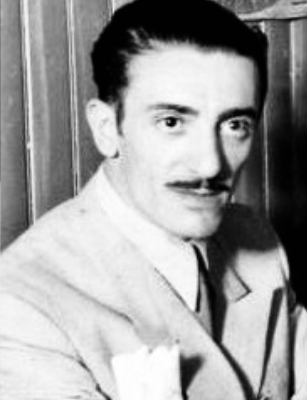(from Wikipedia, ElRecordo.com )
Pianist, composer and leader (March 14, 1906, in Buenos Aires – September 24, 1969)
Rodolfo Biagi was born in Buenos Aires, San Telmo district. Following primary studies, he leaves the school to focus on music. He starts with the violin, but turns to piano quite quickly. With 13 years old, but without his parents’ knowledge, he plays for silent cinema. Juan Maglio notices him there, and invites him to play together. Rodolfo Biagi career starts as pianist, and later as composer and conductor. Through D’Arienzo, he will influence the tango music at the end of the 30’s, and his Manos Brujas (bewitched hands) still make us dance in today’s milongas.
Biagi starts at Marabú cabaret, and here we go with now 2 big orchestras at the end of the 30’s! Juan D’Arienzo does not lose the metronome ; Biagi put in practice his novel ideas and defines his own and unique style: El Incendio, El 13 (1938), La Maleva, Pura Clase (1939)… The first singer to join the orchestras is Teofilo Ibañez on Gólgota(composed par Biagi). Then András Falgás in 1939 records outstanding valses: Dichas que viví, El Último Adiós, Dejame Amarte Aunque Sea Un Día (1939)…
The style of Rodolfo Biagi is mainly focused on the downbeat. Like Juan D’Arienzo, Biagi uses to emphasize 4 accents per time which increases the sensation of speed. However, while D’Arienzo is a real metronome that never gives up, Biagi is less systematic and authorizes some slower phrases, at the benefit of melody and voice. This is more noticeable from 1942 (Si de mi te has olvidado, Lison, Tus labios me dirán), and brings a more sentimental mood. Biagi uses to let a melodic phrase to the violins, and sustain it by a rhythmical background with bandoneons. It is also important to mention the key role of the piano: he punctuates the end of the phrases with a fast and vigorous arpeggio, typical from the maestro, and usually performs a solo at piano, just before a final variation at bandoneons and/or a vocal part. But the main particularity of Rodolfo Biagi is the regular use of the off-beat accent.
Sample Tango Music by Rodolfo Biagi
The songs below are representative of tango music as a whole. There are three types of Tango music that you’ll hear at a Milonga (a tango dance party):
1.) Tango, which is 4/4 time, meaning there are 4 beats per measure.
2.) Milonga, which is a style of music, a dance party itself, and a style of dance done to the style of music. Milonga music is typically 2/4 time, meaning there are 2 beats per measure and has a very distinctive type of rhythm which is known as the ‘Habanera’ Rhythm.
3.) And lastly there is Vals music which has a very distinctive ‘lilt’ to the music indicative of 3/4 time signature or 3 beats per measure.
Rodolfo Biagi – Belgica – Tango Example
Rodolfo Biagi – Amor y Vals – Vals Example.
Rodolfo Biagi – Flor de Montserrat – Milonga Example.
Habanera Example Used In Milonga Music.

